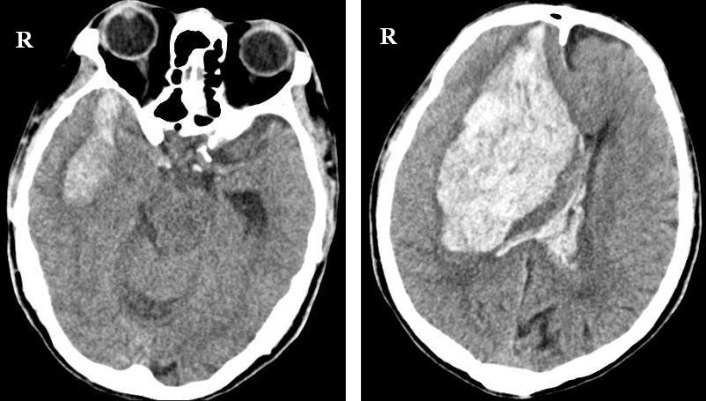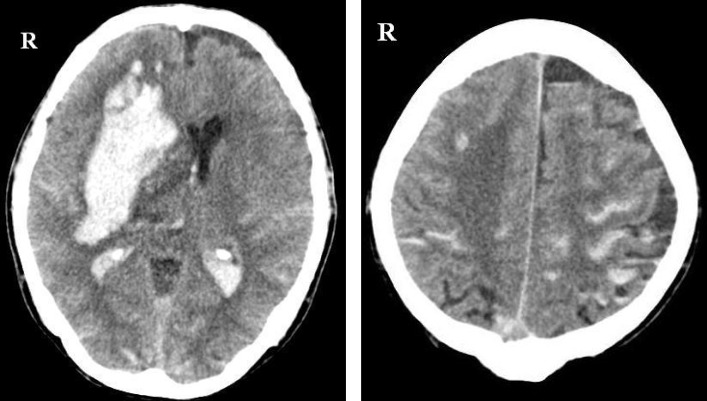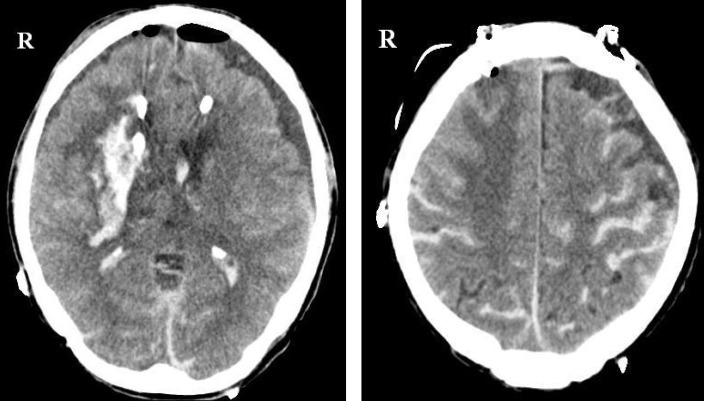J Cerebrovasc Endovasc Neurosurg.
2012 Jun;14(2):104-107. 10.7461/jcen.2012.14.2.104.
Rapid Spontaneous Reduction of a Huge Intracerebral Hematoma
- Affiliations
-
- 1Department of Neurosurgery, Kangnam Sacred Heart Hospital, Hallym University Medical Center, College of Medicine, Hallym University, Seoul, Korea. leehokook@me.com
- KMID: 1808445
- DOI: http://doi.org/10.7461/jcen.2012.14.2.104
Abstract
- Rapid reduction of a large acute subdural hematoma has been frequently reported. In my knowledge, however, it was rarely reported that rapid spontaneous reduction occurred in large volume of spontaneous intracerebral hematoma (sICH). We describe a patient with a rapid spontaneous decrease in the volume of a large hematoma. A 73-year-old man presented semi-comatose mentality. Initial brain computed tomography (CT) revealed the huge sICH. An emergency operation was planned, but was not performed due to the refusal of patient's family. Therefore, we decided to treat with conservative therapy. However, follow-up brain CT 16 hours after initial scan showed a remarkable reduction of previous sICH. The mechanism involving the spontaneous rapid decrease of the hematoma is presumed to occur through redistribution in brain atrophy, compression effect from the increased intracranial pressure and dilution through a wash out by the cerebrospinal fluid.
MeSH Terms
Figure
Reference
-
1. Bae HG, Lee KS, Yun IG, Bae WK, Choi SK, Byun BJ, et al. Rapid expansion of hypertensive intracerebral hemorrhage. Neurosurgery. 1992; 7. 31(1):35–41. PMID: 1641108.
Article2. Berker M, Gulsen S, Ozcan OE. Ultra rapid spontaneous resolution of acute posttraumatic subdural hematomas in patient with temporal linear fracture. Acta Neurochir (Wien). 2003; 8. 145(8):715–717. discussion 7. PMID: 14520555.
Article3. Bortolotti C, Wang H, Fraser K, Lanzino G. Subacute spinal subdural hematoma after spontaneous resolution of cranial subdural hematoma: causal relationship or coincidence? Case report. J Neurosurg. 2004; 4. 100(4 Suppl Spine):372–374. PMID: 15070147.4. Bose B, Kraut W, Osterholm JL. Intracerebral hematoma: spontaneous cure by drainage into the middle ear. A case report. Neurosurgery. 1982; 1. 10(1):103–104. PMID: 7057965.5. Broderick JP, Adams HP Jr, Barsan W, Feinberg W, Feldmann E, Grotta J, et al. Guidelines for the management of spontaneous intracerebral hemorrhage: A statement for healthcare professionals from a special writing group of the Stroke Council, American Heart Association. Stroke. 1999; 4. 30(4):905–915. PMID: 10187901.6. Dowlatshahi D, Demchuk AM, Flaherty ML, Ali M, Lyden PL, Smith EE, et al. Defining hematoma expansion in intracerebral hemorrhage: relationship with patient outcomes. Neurology. 2011; 4. 05. 76(14):1238–1244. PMID: 21346218.
Article7. Elliott J, Smith M. The acute management of intracerebral hemorrhage: a clinical review. Anesth Analg. 2010; 5. 01. 110(5):1419–1427. PMID: 20332192.8. Imai K. Rapid spontaneous resolution of signs of intracranial herniation due to subdural hematoma-case report. Neurol Med Chir (Tokyo). 2003; 3. 43(3):125–129. PMID: 12699119.9. Inamasu J, Nakamura Y, Saito R, Kuroshima Y, Mayanagi K, Ohba S, et al. Rapid resolution of traumatic acute subdural hematoma by redistribution. Am J Emerg Med. 2002; 7. 20(4):376–377. PMID: 12098195.
Article10. Kang SH, Chung YG, Lee HK. Rapid disappearance of acute posterior fossa epidural hematoma. Neurol Med Chir (Tokyo). 2005; 9. 45(9):462–463. PMID: 16195645.11. Kato N, Tsunoda T, Matsumura A, Yanaka K, Nose T. Rapid spontaneous resolution of acute subdural hematoma occurs by redistribution-Two case reports. Neurol Med Chir (Tokyo). 2001; 3. 41(3):140–143. PMID: 11372558.12. Kundra SN, Kundra R. Extracranial redistribution causing rapid spontaneous resolution of acute subdural hematoma. Neurol India. 2005; 3. 53(1):124. PMID: 15805677.
Article13. Lee CH, Kang DH, Hwang SH, Park IS, Jung JM, Han JW. Spontaneous rapid reduction of a large acute subdural hematoma. J Korean Med Sci. 2009; 12. 24(6):1224–1226. PMID: 19949689.
Article14. Moon CT, Lim SJ, Yoon SH, Cho J, Chang SK. [Acute expansion of hematoma in Hypertensive Intracerebral hemorrhage]. Korean J Cerebrovasc Dis. 2001; 9. 3(2):163–168. Korean.15. Parker D Jr, Rhoney DH, Liu-DeRyke X. Management of spontaneous nontraumatic intracranial hemorrhage. J Pharm Pract. 2010; 10. 23(5):398–407. PMID: 21507845.
Article16. Rosenow F, Hojer C, Meyer-Lohmann C, Hilgers RD, Muhlhofer H, Kleindienst A, et al. Spontaneous intracerebral hemorrhage. Prognostic factors in 896 cases. Acta Neurol Scand. 1997; 9. 96(3):174–182. PMID: 9300072.17. Sheth KN, Cushing TA, Wendell L, Lev MH, Romero JM, Schwab K, et al. Comparison of hematoma shape and volume estimates in warfarin versus non-warfarin-related intracerebral hemorrhage. Neurocrit Care. 2010; 2. 12(1):30–34. PMID: 19859832.
Article18. Suzuki Y, Kawamata T, Matsumoto H, Kunii N, Matsumoto K. [A resolving sign of acute subdural hematoma: from report of two cases]. No Shinkei Geka. 1998; 11. 26(11):1025–1029. Japanese. PMID: 9834499.19. Wong ST, Yuen MK, Fok KF, Yuen SC, Yam KY, Fong D. Redistribution of hematoma to spinal subdural space as a mechanism for the rapid spontaneous resolution of posttraumatic intracranial acute subdural hematoma: case report. Surg Neurol. 2009; 1. 71(1):99–102. discussion 102. PMID: 18262617.
Article20. Wu MC, Liu JX, Luo GC, Zhang ZW, Min J, Yu H, et al. Rapid natural resolution of intracranial hematoma. Chin J Traumatol. 2004; 4. 7(2):96–100. PMID: 15294128.
- Full Text Links
- Actions
-
Cited
- CITED
-
- Close
- Share
- Similar articles
-
- "Contralateral" Acute Subdural and Intracerebral Hemorrhage Occurring Simultaneously after Evacuation of Huge Chronic Subdural Hematoma
- Organized Expanding Spontaneous Intracerebral Hematoma
- Efficacy of Percutaneous Needle Aspiration for Evacuation of Intracerebral Hemorrhage: A Volumetric and Clincal Outcone Study
- A Case of Spontaneous Intracerebral Hematoma in Childhood
- Comparative Clinical Analysis of Stereotaxic Surgery vs Conservative Treatment for Spontaneous Intracerebral Hematoma




